CHCCCS003 Increase the Safety of Individuals at Risk of Suicide
VerifiedAdded on 2023/06/08
|16
|3418
|477
AI Summary
This resource covers key topics such as identifying and assessing a person's current suicide risk, collaborating to increase immediate safety, facilitating links to further support, and reviewing and reporting on support provided. It also includes assessment tasks such as a written assignment, project, and observation role play. The resource provides flexibility of assessment for students with learning needs such as English as a second language or disabilities. The project assessment tasks include outlining how to identify and assess an individual's risk of suicide, exploring indications of suicide, asking questions and facilitating intervention, and empowering clients to make informed choices about future help and maintaining rapport to encourage discussion of on-going concerns.
Contribute Materials
Your contribution can guide someone’s learning journey. Share your
documents today.

Secure Best Marks with AI Grader
Need help grading? Try our AI Grader for instant feedback on your assignments.
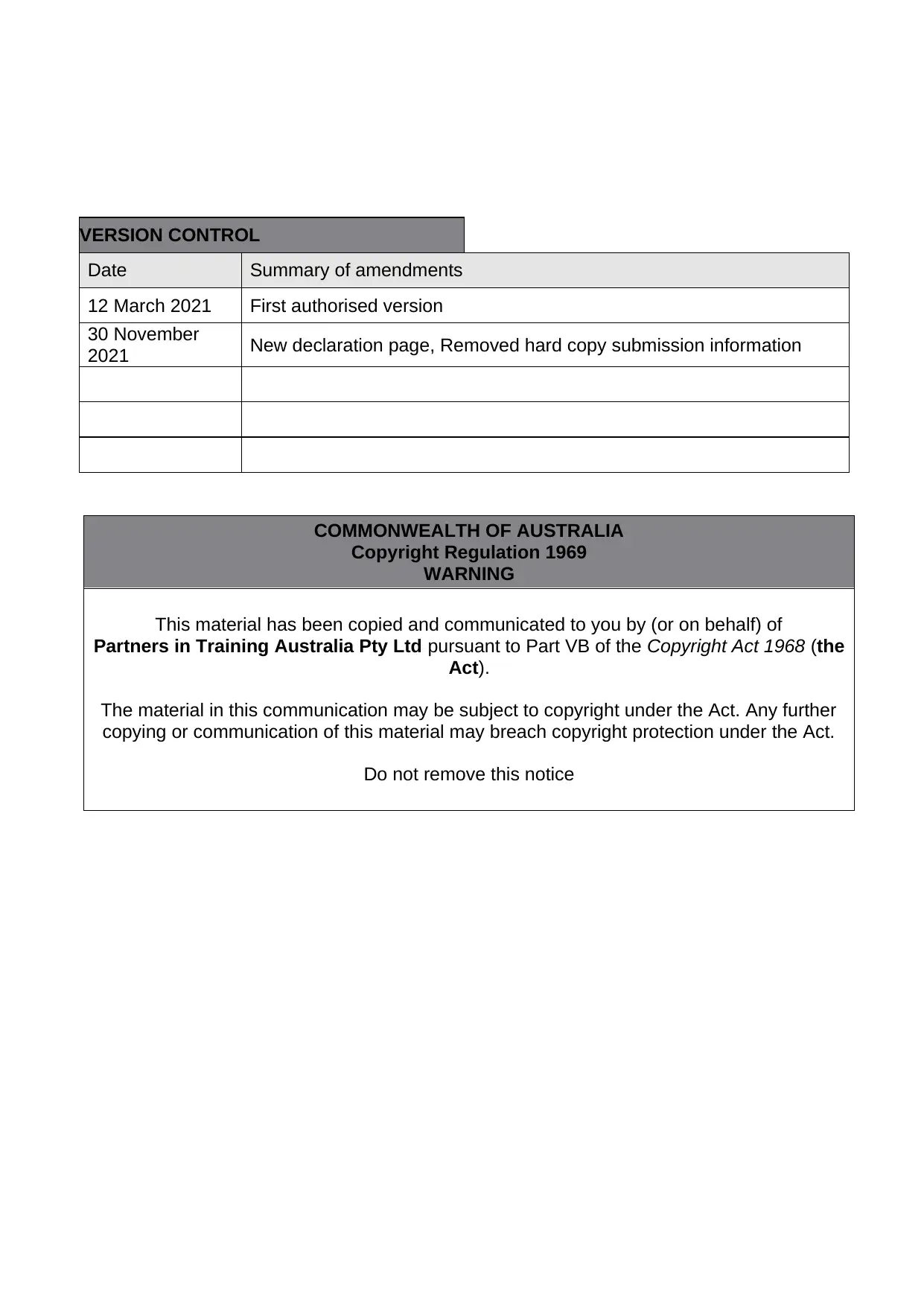
VERSION CONTROL
Date Summary of amendments
12 March 2021 First authorised version
30 November
2021 New declaration page, Removed hard copy submission information
COMMONWEALTH OF AUSTRALIA
Copyright Regulation 1969
WARNING
This material has been copied and communicated to you by (or on behalf) of
Partners in Training Australia Pty Ltd pursuant to Part VB of the Copyright Act 1968 (the
Act).
The material in this communication may be subject to copyright under the Act. Any further
copying or communication of this material may breach copyright protection under the Act.
Do not remove this notice
Date Summary of amendments
12 March 2021 First authorised version
30 November
2021 New declaration page, Removed hard copy submission information
COMMONWEALTH OF AUSTRALIA
Copyright Regulation 1969
WARNING
This material has been copied and communicated to you by (or on behalf) of
Partners in Training Australia Pty Ltd pursuant to Part VB of the Copyright Act 1968 (the
Act).
The material in this communication may be subject to copyright under the Act. Any further
copying or communication of this material may breach copyright protection under the Act.
Do not remove this notice

CONTENTS
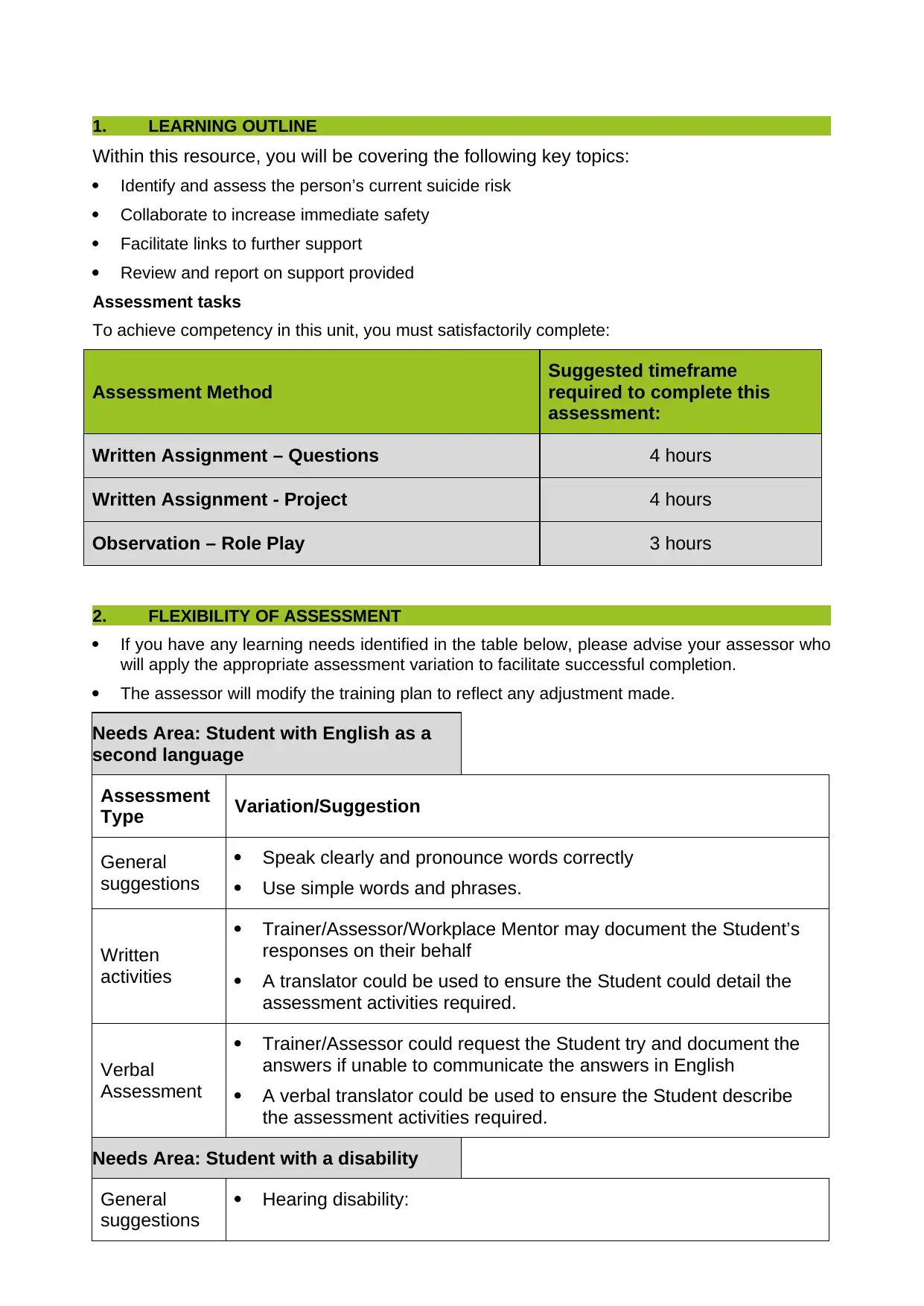
1. LEARNING OUTLINE
Within this resource, you will be covering the following key topics:
Identify and assess the person’s current suicide risk
Collaborate to increase immediate safety
Facilitate links to further support
Review and report on support provided
Assessment tasks
To achieve competency in this unit, you must satisfactorily complete:
Assessment Method
Suggested timeframe
required to complete this
assessment:
Written Assignment – Questions 4 hours
Written Assignment - Project 4 hours
Observation – Role Play 3 hours
2. FLEXIBILITY OF ASSESSMENT
If you have any learning needs identified in the table below, please advise your assessor who
will apply the appropriate assessment variation to facilitate successful completion.
The assessor will modify the training plan to reflect any adjustment made.
Needs Area: Student with English as a
second language
Assessment
Type Variation/Suggestion
General
suggestions
Speak clearly and pronounce words correctly
Use simple words and phrases.
Written
activities
Trainer/Assessor/Workplace Mentor may document the Student’s
responses on their behalf
A translator could be used to ensure the Student could detail the
assessment activities required.
Verbal
Assessment
Trainer/Assessor could request the Student try and document the
answers if unable to communicate the answers in English
A verbal translator could be used to ensure the Student describe
the assessment activities required.
Needs Area: Student with a disability
General
suggestions
Hearing disability:
Within this resource, you will be covering the following key topics:
Identify and assess the person’s current suicide risk
Collaborate to increase immediate safety
Facilitate links to further support
Review and report on support provided
Assessment tasks
To achieve competency in this unit, you must satisfactorily complete:
Assessment Method
Suggested timeframe
required to complete this
assessment:
Written Assignment – Questions 4 hours
Written Assignment - Project 4 hours
Observation – Role Play 3 hours
2. FLEXIBILITY OF ASSESSMENT
If you have any learning needs identified in the table below, please advise your assessor who
will apply the appropriate assessment variation to facilitate successful completion.
The assessor will modify the training plan to reflect any adjustment made.
Needs Area: Student with English as a
second language
Assessment
Type Variation/Suggestion
General
suggestions
Speak clearly and pronounce words correctly
Use simple words and phrases.
Written
activities
Trainer/Assessor/Workplace Mentor may document the Student’s
responses on their behalf
A translator could be used to ensure the Student could detail the
assessment activities required.
Verbal
Assessment
Trainer/Assessor could request the Student try and document the
answers if unable to communicate the answers in English
A verbal translator could be used to ensure the Student describe
the assessment activities required.
Needs Area: Student with a disability
General
suggestions
Hearing disability:
Secure Best Marks with AI Grader
Need help grading? Try our AI Grader for instant feedback on your assignments.
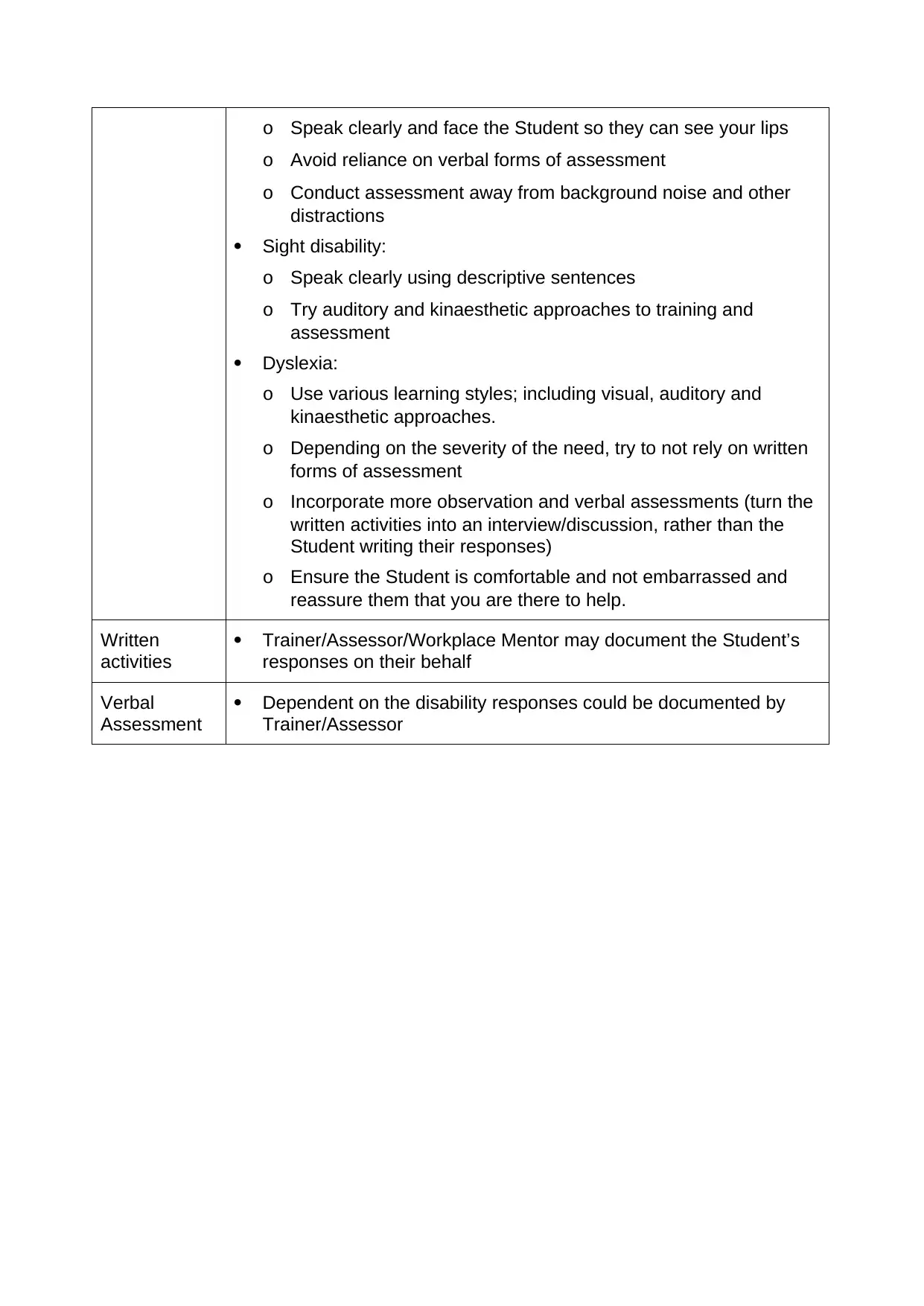
o Speak clearly and face the Student so they can see your lips
o Avoid reliance on verbal forms of assessment
o Conduct assessment away from background noise and other
distractions
Sight disability:
o Speak clearly using descriptive sentences
o Try auditory and kinaesthetic approaches to training and
assessment
Dyslexia:
o Use various learning styles; including visual, auditory and
kinaesthetic approaches.
o Depending on the severity of the need, try to not rely on written
forms of assessment
o Incorporate more observation and verbal assessments (turn the
written activities into an interview/discussion, rather than the
Student writing their responses)
o Ensure the Student is comfortable and not embarrassed and
reassure them that you are there to help.
Written
activities
Trainer/Assessor/Workplace Mentor may document the Student’s
responses on their behalf
Verbal
Assessment
Dependent on the disability responses could be documented by
Trainer/Assessor
o Avoid reliance on verbal forms of assessment
o Conduct assessment away from background noise and other
distractions
Sight disability:
o Speak clearly using descriptive sentences
o Try auditory and kinaesthetic approaches to training and
assessment
Dyslexia:
o Use various learning styles; including visual, auditory and
kinaesthetic approaches.
o Depending on the severity of the need, try to not rely on written
forms of assessment
o Incorporate more observation and verbal assessments (turn the
written activities into an interview/discussion, rather than the
Student writing their responses)
o Ensure the Student is comfortable and not embarrassed and
reassure them that you are there to help.
Written
activities
Trainer/Assessor/Workplace Mentor may document the Student’s
responses on their behalf
Verbal
Assessment
Dependent on the disability responses could be documented by
Trainer/Assessor
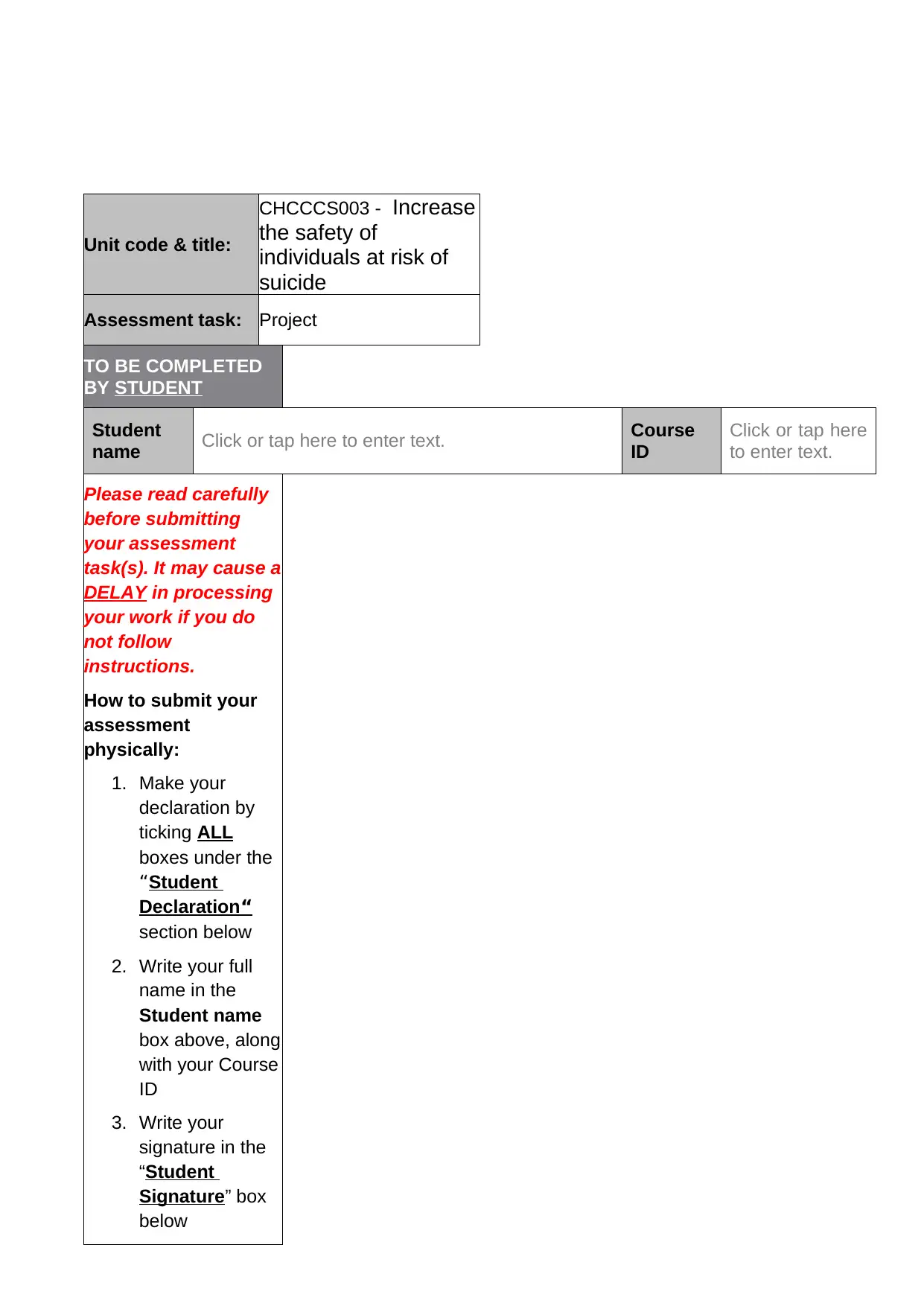
Unit code & title:
CHCCCS003 - Increase
the safety of
individuals at risk of
suicide
Assessment task: Project
TO BE COMPLETED
BY STUDENT
Student
name Click or tap here to enter text. Course
ID
Click or tap here
to enter text.
Please read carefully
before submitting
your assessment
task(s). It may cause a
DELAY in processing
your work if you do
not follow
instructions.
How to submit your
assessment
physically:
1. Make your
declaration by
ticking ALL
boxes under the
“Student
Declaration“
section below
2. Write your full
name in the
Student name
box above, along
with your Course
ID
3. Write your
signature in the
“Student
Signature” box
below
CHCCCS003 - Increase
the safety of
individuals at risk of
suicide
Assessment task: Project
TO BE COMPLETED
BY STUDENT
Student
name Click or tap here to enter text. Course
ID
Click or tap here
to enter text.
Please read carefully
before submitting
your assessment
task(s). It may cause a
DELAY in processing
your work if you do
not follow
instructions.
How to submit your
assessment
physically:
1. Make your
declaration by
ticking ALL
boxes under the
“Student
Declaration“
section below
2. Write your full
name in the
Student name
box above, along
with your Course
ID
3. Write your
signature in the
“Student
Signature” box
below
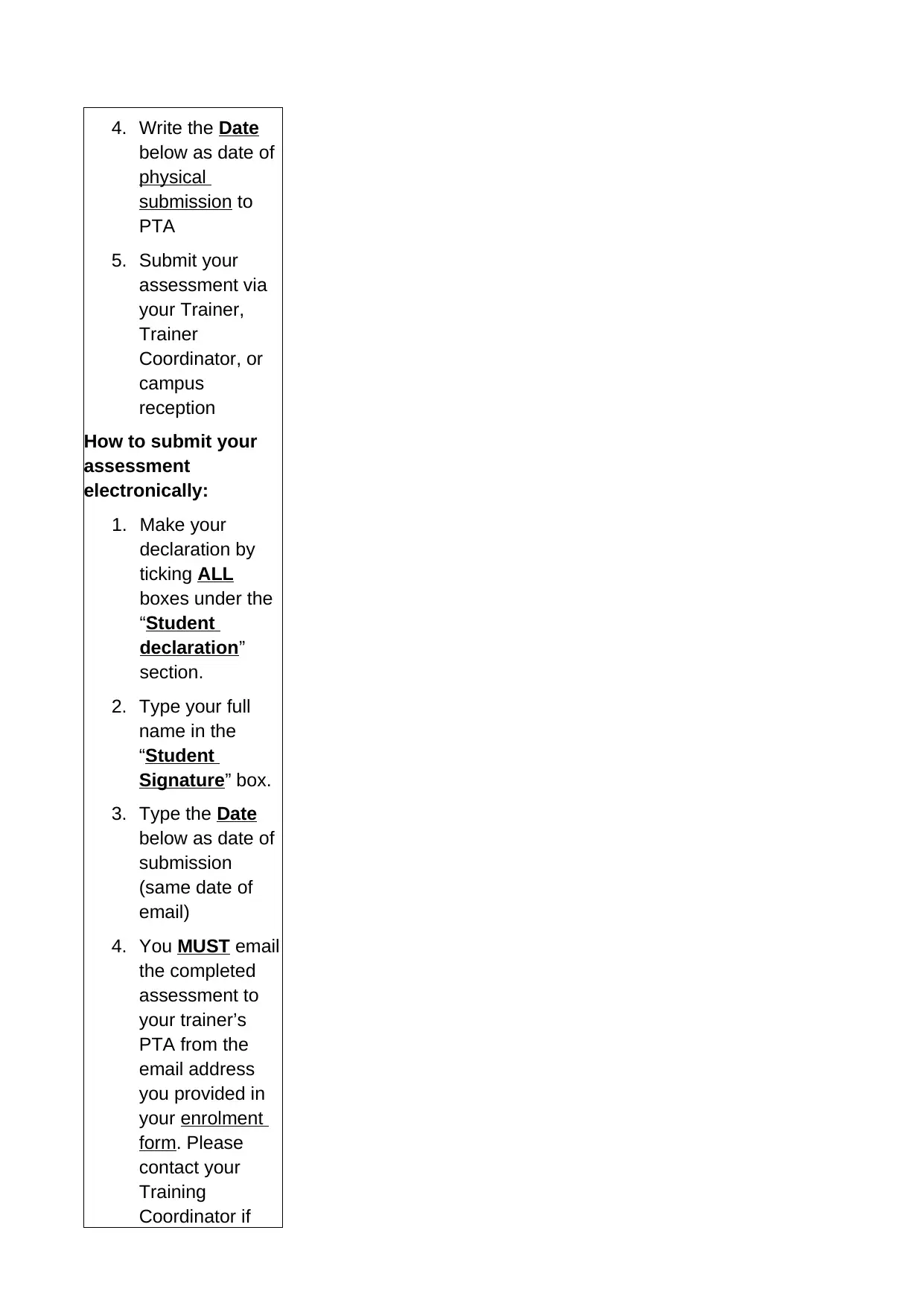
4. Write the Date
below as date of
physical
submission to
PTA
5. Submit your
assessment via
your Trainer,
Trainer
Coordinator, or
campus
reception
How to submit your
assessment
electronically:
1. Make your
declaration by
ticking ALL
boxes under the
“Student
declaration”
section.
2. Type your full
name in the
“Student
Signature” box.
3. Type the Date
below as date of
submission
(same date of
email)
4. You MUST email
the completed
assessment to
your trainer’s
PTA from the
email address
you provided in
your enrolment
form. Please
contact your
Training
Coordinator if
below as date of
physical
submission to
PTA
5. Submit your
assessment via
your Trainer,
Trainer
Coordinator, or
campus
reception
How to submit your
assessment
electronically:
1. Make your
declaration by
ticking ALL
boxes under the
“Student
declaration”
section.
2. Type your full
name in the
“Student
Signature” box.
3. Type the Date
below as date of
submission
(same date of
email)
4. You MUST email
the completed
assessment to
your trainer’s
PTA from the
email address
you provided in
your enrolment
form. Please
contact your
Training
Coordinator if
Paraphrase This Document
Need a fresh take? Get an instant paraphrase of this document with our AI Paraphraser
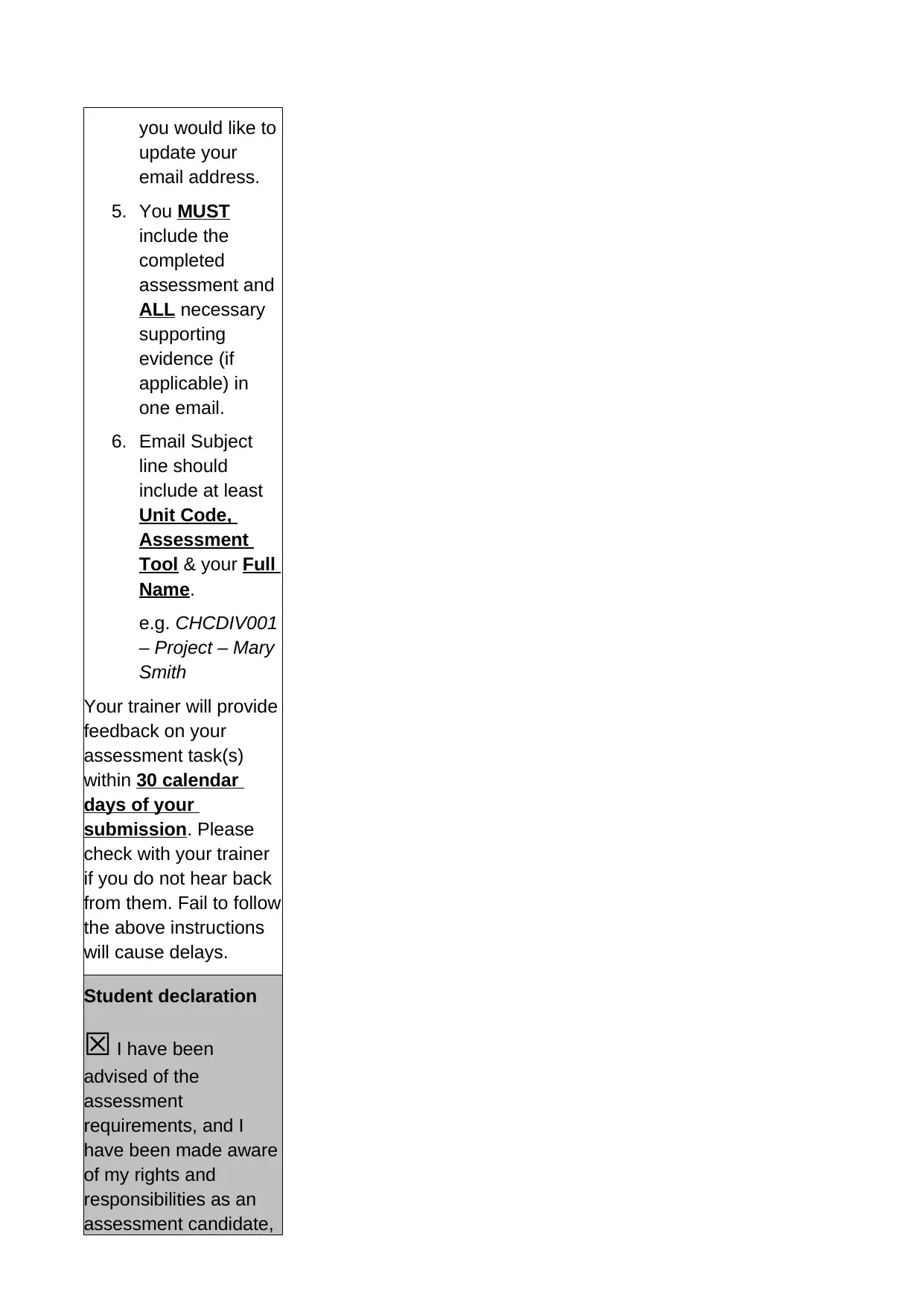
you would like to
update your
email address.
5. You MUST
include the
completed
assessment and
ALL necessary
supporting
evidence (if
applicable) in
one email.
6. Email Subject
line should
include at least
Unit Code,
Assessment
Tool & your Full
Name.
e.g. CHCDIV001
– Project – Mary
Smith
Your trainer will provide
feedback on your
assessment task(s)
within 30 calendar
days of your
submission. Please
check with your trainer
if you do not hear back
from them. Fail to follow
the above instructions
will cause delays.
Student declaration
☒ I have been
advised of the
assessment
requirements, and I
have been made aware
of my rights and
responsibilities as an
assessment candidate,
update your
email address.
5. You MUST
include the
completed
assessment and
ALL necessary
supporting
evidence (if
applicable) in
one email.
6. Email Subject
line should
include at least
Unit Code,
Assessment
Tool & your Full
Name.
e.g. CHCDIV001
– Project – Mary
Smith
Your trainer will provide
feedback on your
assessment task(s)
within 30 calendar
days of your
submission. Please
check with your trainer
if you do not hear back
from them. Fail to follow
the above instructions
will cause delays.
Student declaration
☒ I have been
advised of the
assessment
requirements, and I
have been made aware
of my rights and
responsibilities as an
assessment candidate,
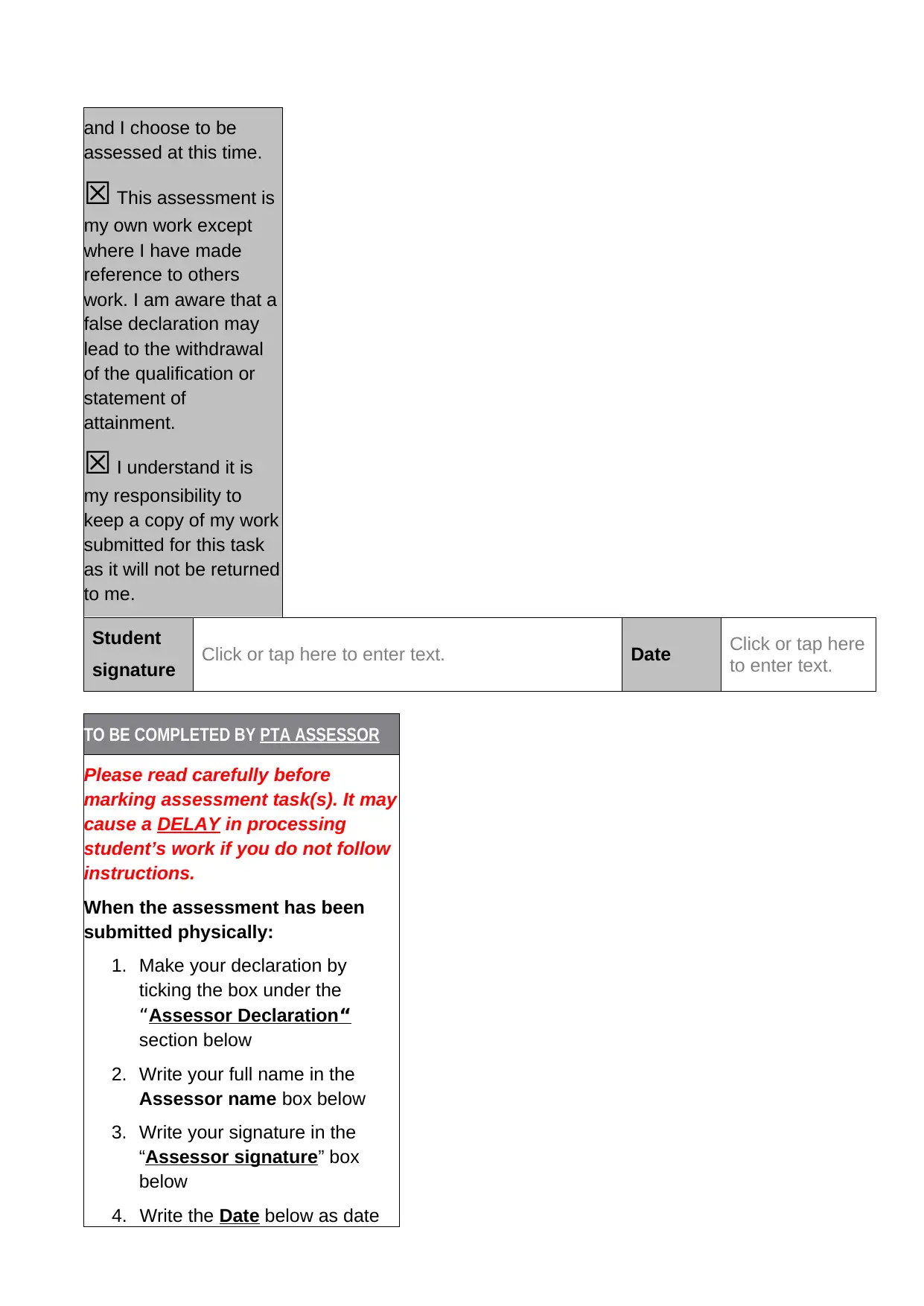
and I choose to be
assessed at this time.
☒ This assessment is
my own work except
where I have made
reference to others
work. I am aware that a
false declaration may
lead to the withdrawal
of the qualification or
statement of
attainment.
☒ I understand it is
my responsibility to
keep a copy of my work
submitted for this task
as it will not be returned
to me.
Student
signature Click or tap here to enter text. Date Click or tap here
to enter text.
TO BE COMPLETED BY PTA ASSESSOR
Please read carefully before
marking assessment task(s). It may
cause a DELAY in processing
student’s work if you do not follow
instructions.
When the assessment has been
submitted physically:
1. Make your declaration by
ticking the box under the
“Assessor Declaration“
section below
2. Write your full name in the
Assessor name box below
3. Write your signature in the
“Assessor signature” box
below
4. Write the Date below as date
assessed at this time.
☒ This assessment is
my own work except
where I have made
reference to others
work. I am aware that a
false declaration may
lead to the withdrawal
of the qualification or
statement of
attainment.
☒ I understand it is
my responsibility to
keep a copy of my work
submitted for this task
as it will not be returned
to me.
Student
signature Click or tap here to enter text. Date Click or tap here
to enter text.
TO BE COMPLETED BY PTA ASSESSOR
Please read carefully before
marking assessment task(s). It may
cause a DELAY in processing
student’s work if you do not follow
instructions.
When the assessment has been
submitted physically:
1. Make your declaration by
ticking the box under the
“Assessor Declaration“
section below
2. Write your full name in the
Assessor name box below
3. Write your signature in the
“Assessor signature” box
below
4. Write the Date below as date
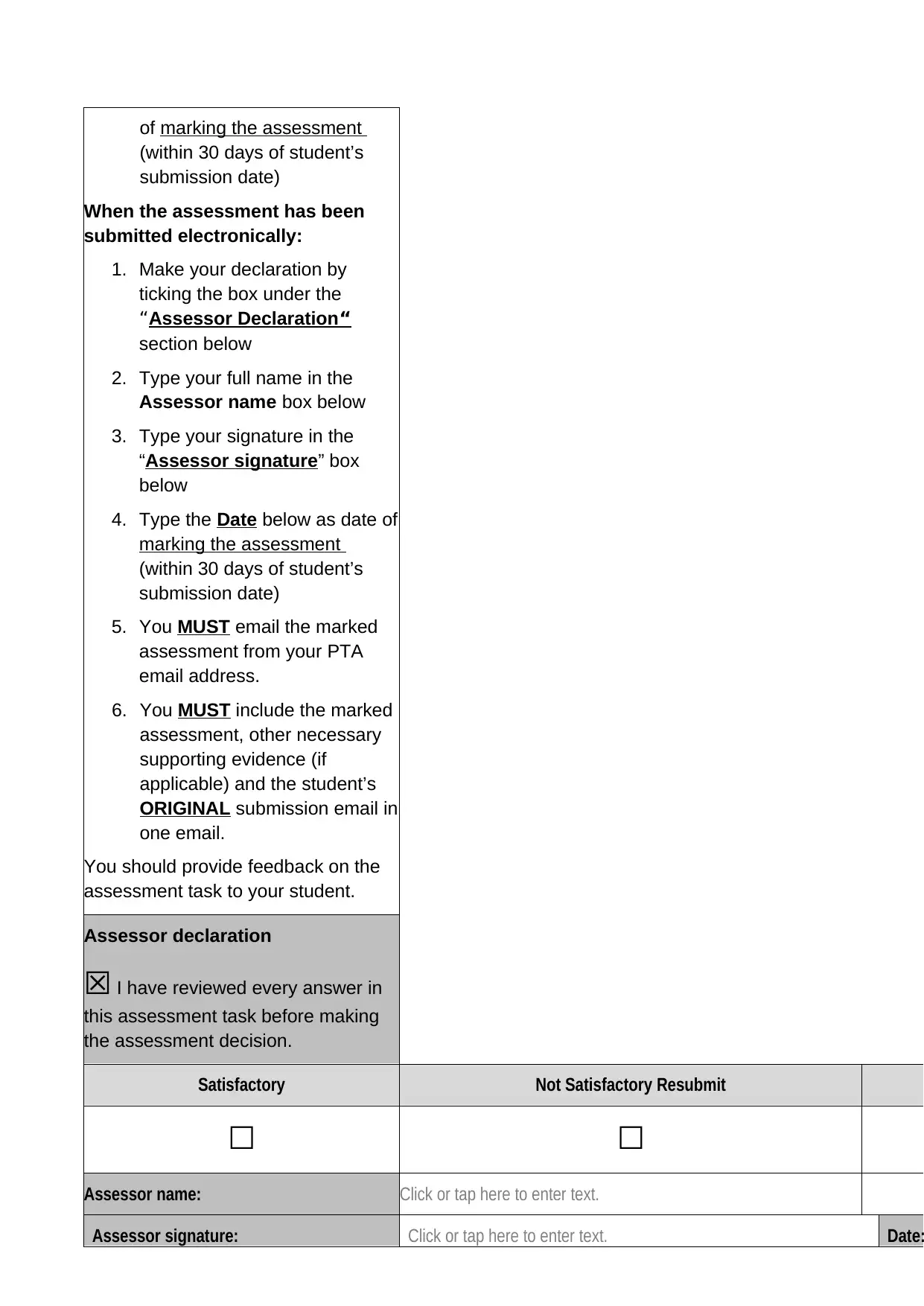
of marking the assessment
(within 30 days of student’s
submission date)
When the assessment has been
submitted electronically:
1. Make your declaration by
ticking the box under the
“Assessor Declaration“
section below
2. Type your full name in the
Assessor name box below
3. Type your signature in the
“Assessor signature” box
below
4. Type the Date below as date of
marking the assessment
(within 30 days of student’s
submission date)
5. You MUST email the marked
assessment from your PTA
email address.
6. You MUST include the marked
assessment, other necessary
supporting evidence (if
applicable) and the student’s
ORIGINAL submission email in
one email.
You should provide feedback on the
assessment task to your student.
Assessor declaration
☒ I have reviewed every answer in
this assessment task before making
the assessment decision.
Satisfactory Not Satisfactory Resubmit
☐ ☐
Assessor name: Click or tap here to enter text.
Assessor signature: Click or tap here to enter text. Date:
(within 30 days of student’s
submission date)
When the assessment has been
submitted electronically:
1. Make your declaration by
ticking the box under the
“Assessor Declaration“
section below
2. Type your full name in the
Assessor name box below
3. Type your signature in the
“Assessor signature” box
below
4. Type the Date below as date of
marking the assessment
(within 30 days of student’s
submission date)
5. You MUST email the marked
assessment from your PTA
email address.
6. You MUST include the marked
assessment, other necessary
supporting evidence (if
applicable) and the student’s
ORIGINAL submission email in
one email.
You should provide feedback on the
assessment task to your student.
Assessor declaration
☒ I have reviewed every answer in
this assessment task before making
the assessment decision.
Satisfactory Not Satisfactory Resubmit
☐ ☐
Assessor name: Click or tap here to enter text.
Assessor signature: Click or tap here to enter text. Date:
Secure Best Marks with AI Grader
Need help grading? Try our AI Grader for instant feedback on your assignments.

Feedback to student:
Click or tap here to enter text.
Click or tap here to enter text.
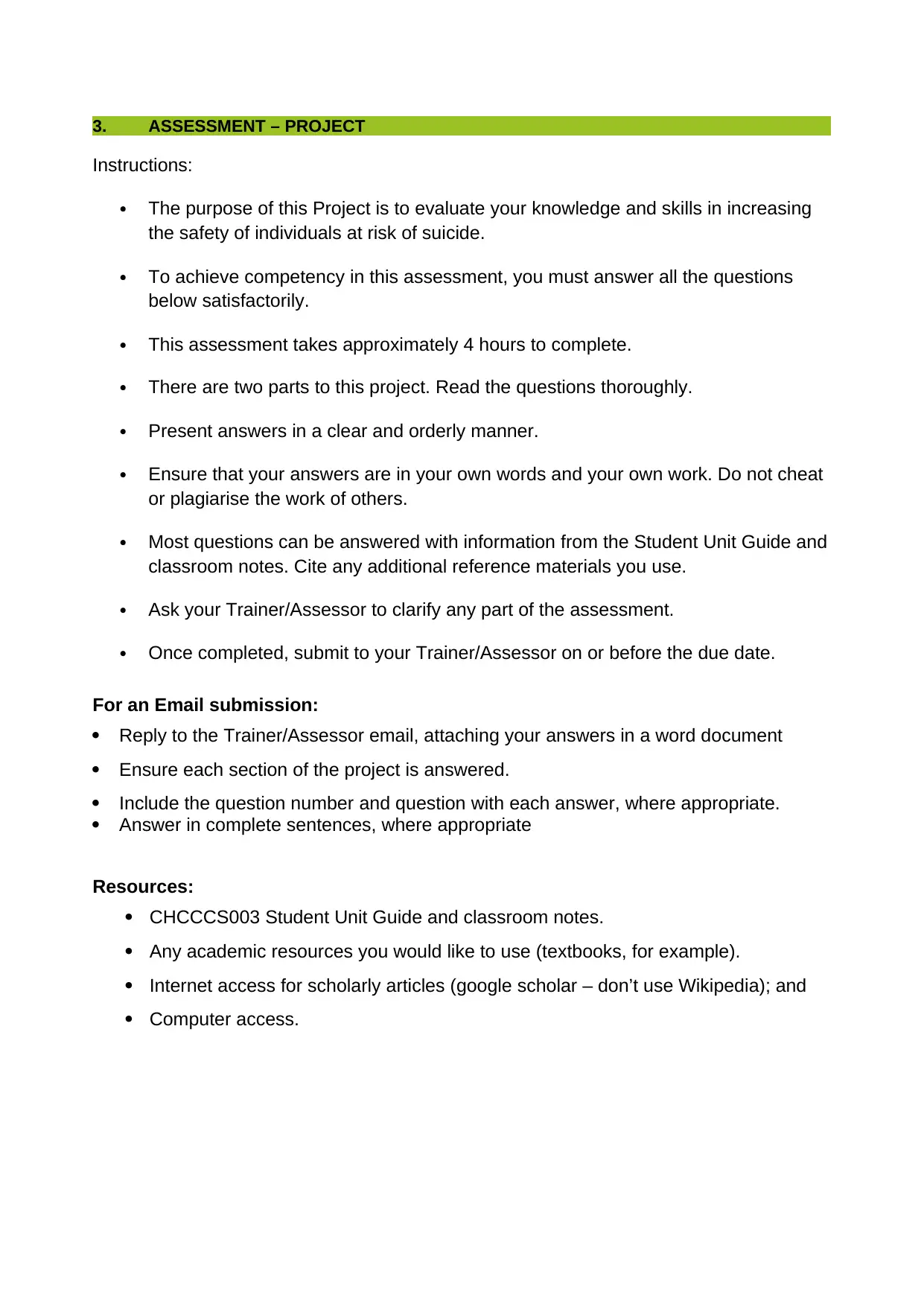
3. ASSESSMENT – PROJECT
Instructions:
The purpose of this Project is to evaluate your knowledge and skills in increasing
the safety of individuals at risk of suicide.
To achieve competency in this assessment, you must answer all the questions
below satisfactorily.
This assessment takes approximately 4 hours to complete.
There are two parts to this project. Read the questions thoroughly.
Present answers in a clear and orderly manner.
Ensure that your answers are in your own words and your own work. Do not cheat
or plagiarise the work of others.
Most questions can be answered with information from the Student Unit Guide and
classroom notes. Cite any additional reference materials you use.
Ask your Trainer/Assessor to clarify any part of the assessment.
Once completed, submit to your Trainer/Assessor on or before the due date.
For an Email submission:
Reply to the Trainer/Assessor email, attaching your answers in a word document
Ensure each section of the project is answered.
Include the question number and question with each answer, where appropriate.
Answer in complete sentences, where appropriate
Resources:
CHCCCS003 Student Unit Guide and classroom notes.
Any academic resources you would like to use (textbooks, for example).
Internet access for scholarly articles (google scholar – don’t use Wikipedia); and
Computer access.
Instructions:
The purpose of this Project is to evaluate your knowledge and skills in increasing
the safety of individuals at risk of suicide.
To achieve competency in this assessment, you must answer all the questions
below satisfactorily.
This assessment takes approximately 4 hours to complete.
There are two parts to this project. Read the questions thoroughly.
Present answers in a clear and orderly manner.
Ensure that your answers are in your own words and your own work. Do not cheat
or plagiarise the work of others.
Most questions can be answered with information from the Student Unit Guide and
classroom notes. Cite any additional reference materials you use.
Ask your Trainer/Assessor to clarify any part of the assessment.
Once completed, submit to your Trainer/Assessor on or before the due date.
For an Email submission:
Reply to the Trainer/Assessor email, attaching your answers in a word document
Ensure each section of the project is answered.
Include the question number and question with each answer, where appropriate.
Answer in complete sentences, where appropriate
Resources:
CHCCCS003 Student Unit Guide and classroom notes.
Any academic resources you would like to use (textbooks, for example).
Internet access for scholarly articles (google scholar – don’t use Wikipedia); and
Computer access.
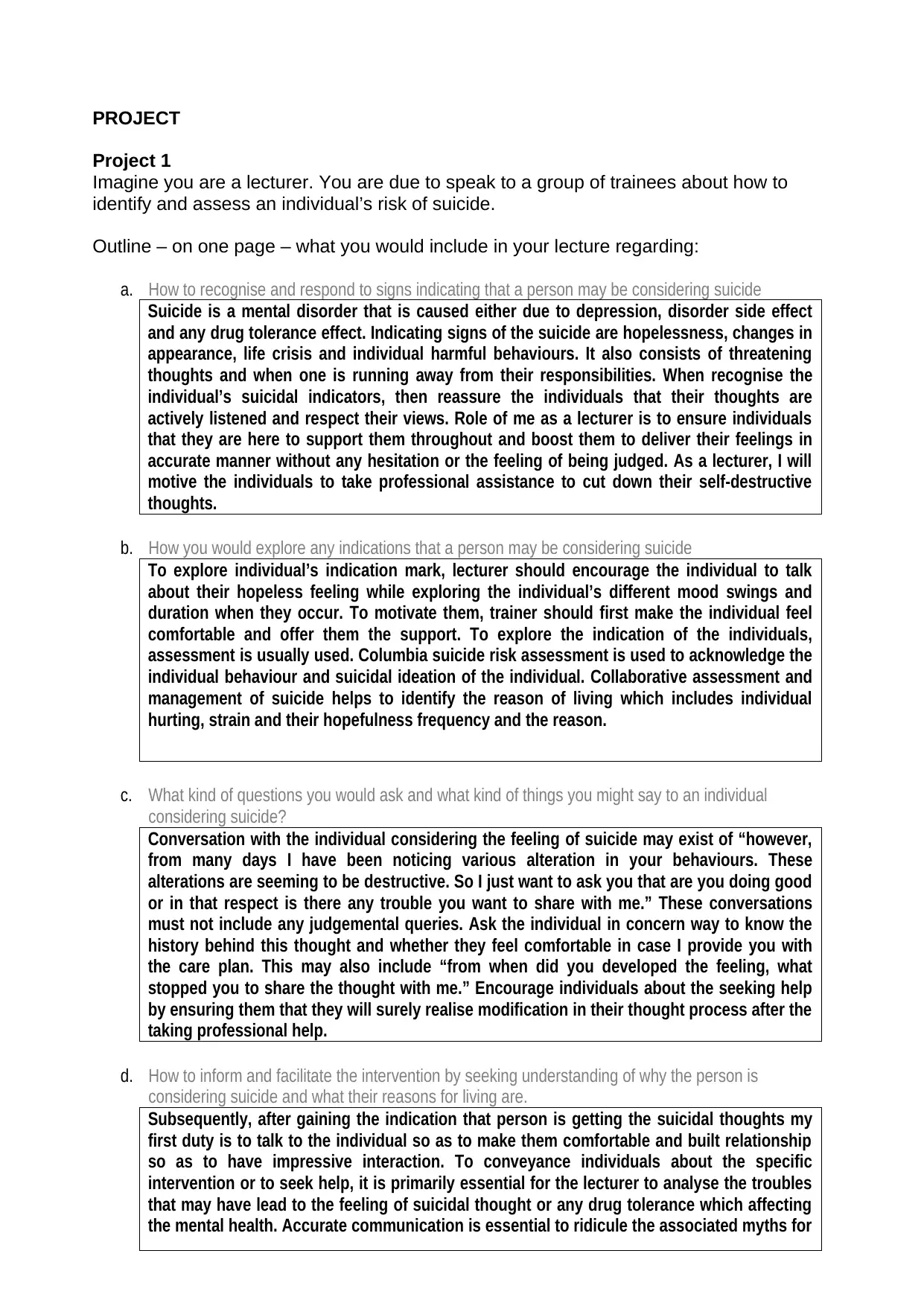
PROJECT
Project 1
Imagine you are a lecturer. You are due to speak to a group of trainees about how to
identify and assess an individual’s risk of suicide.
Outline – on one page – what you would include in your lecture regarding:
a. How to recognise and respond to signs indicating that a person may be considering suicide
Suicide is a mental disorder that is caused either due to depression, disorder side effect
and any drug tolerance effect. Indicating signs of the suicide are hopelessness, changes in
appearance, life crisis and individual harmful behaviours. It also consists of threatening
thoughts and when one is running away from their responsibilities. When recognise the
individual’s suicidal indicators, then reassure the individuals that their thoughts are
actively listened and respect their views. Role of me as a lecturer is to ensure individuals
that they are here to support them throughout and boost them to deliver their feelings in
accurate manner without any hesitation or the feeling of being judged. As a lecturer, I will
motive the individuals to take professional assistance to cut down their self-destructive
thoughts.
b. How you would explore any indications that a person may be considering suicide
To explore individual’s indication mark, lecturer should encourage the individual to talk
about their hopeless feeling while exploring the individual’s different mood swings and
duration when they occur. To motivate them, trainer should first make the individual feel
comfortable and offer them the support. To explore the indication of the individuals,
assessment is usually used. Columbia suicide risk assessment is used to acknowledge the
individual behaviour and suicidal ideation of the individual. Collaborative assessment and
management of suicide helps to identify the reason of living which includes individual
hurting, strain and their hopefulness frequency and the reason.
c. What kind of questions you would ask and what kind of things you might say to an individual
considering suicide?
Conversation with the individual considering the feeling of suicide may exist of “however,
from many days I have been noticing various alteration in your behaviours. These
alterations are seeming to be destructive. So I just want to ask you that are you doing good
or in that respect is there any trouble you want to share with me.” These conversations
must not include any judgemental queries. Ask the individual in concern way to know the
history behind this thought and whether they feel comfortable in case I provide you with
the care plan. This may also include “from when did you developed the feeling, what
stopped you to share the thought with me.” Encourage individuals about the seeking help
by ensuring them that they will surely realise modification in their thought process after the
taking professional help.
d. How to inform and facilitate the intervention by seeking understanding of why the person is
considering suicide and what their reasons for living are.
Subsequently, after gaining the indication that person is getting the suicidal thoughts my
first duty is to talk to the individual so as to make them comfortable and built relationship
so as to have impressive interaction. To conveyance individuals about the specific
intervention or to seek help, it is primarily essential for the lecturer to analyse the troubles
that may have lead to the feeling of suicidal thought or any drug tolerance which affecting
the mental health. Accurate communication is essential to ridicule the associated myths for
Project 1
Imagine you are a lecturer. You are due to speak to a group of trainees about how to
identify and assess an individual’s risk of suicide.
Outline – on one page – what you would include in your lecture regarding:
a. How to recognise and respond to signs indicating that a person may be considering suicide
Suicide is a mental disorder that is caused either due to depression, disorder side effect
and any drug tolerance effect. Indicating signs of the suicide are hopelessness, changes in
appearance, life crisis and individual harmful behaviours. It also consists of threatening
thoughts and when one is running away from their responsibilities. When recognise the
individual’s suicidal indicators, then reassure the individuals that their thoughts are
actively listened and respect their views. Role of me as a lecturer is to ensure individuals
that they are here to support them throughout and boost them to deliver their feelings in
accurate manner without any hesitation or the feeling of being judged. As a lecturer, I will
motive the individuals to take professional assistance to cut down their self-destructive
thoughts.
b. How you would explore any indications that a person may be considering suicide
To explore individual’s indication mark, lecturer should encourage the individual to talk
about their hopeless feeling while exploring the individual’s different mood swings and
duration when they occur. To motivate them, trainer should first make the individual feel
comfortable and offer them the support. To explore the indication of the individuals,
assessment is usually used. Columbia suicide risk assessment is used to acknowledge the
individual behaviour and suicidal ideation of the individual. Collaborative assessment and
management of suicide helps to identify the reason of living which includes individual
hurting, strain and their hopefulness frequency and the reason.
c. What kind of questions you would ask and what kind of things you might say to an individual
considering suicide?
Conversation with the individual considering the feeling of suicide may exist of “however,
from many days I have been noticing various alteration in your behaviours. These
alterations are seeming to be destructive. So I just want to ask you that are you doing good
or in that respect is there any trouble you want to share with me.” These conversations
must not include any judgemental queries. Ask the individual in concern way to know the
history behind this thought and whether they feel comfortable in case I provide you with
the care plan. This may also include “from when did you developed the feeling, what
stopped you to share the thought with me.” Encourage individuals about the seeking help
by ensuring them that they will surely realise modification in their thought process after the
taking professional help.
d. How to inform and facilitate the intervention by seeking understanding of why the person is
considering suicide and what their reasons for living are.
Subsequently, after gaining the indication that person is getting the suicidal thoughts my
first duty is to talk to the individual so as to make them comfortable and built relationship
so as to have impressive interaction. To conveyance individuals about the specific
intervention or to seek help, it is primarily essential for the lecturer to analyse the troubles
that may have lead to the feeling of suicidal thought or any drug tolerance which affecting
the mental health. Accurate communication is essential to ridicule the associated myths for
Paraphrase This Document
Need a fresh take? Get an instant paraphrase of this document with our AI Paraphraser
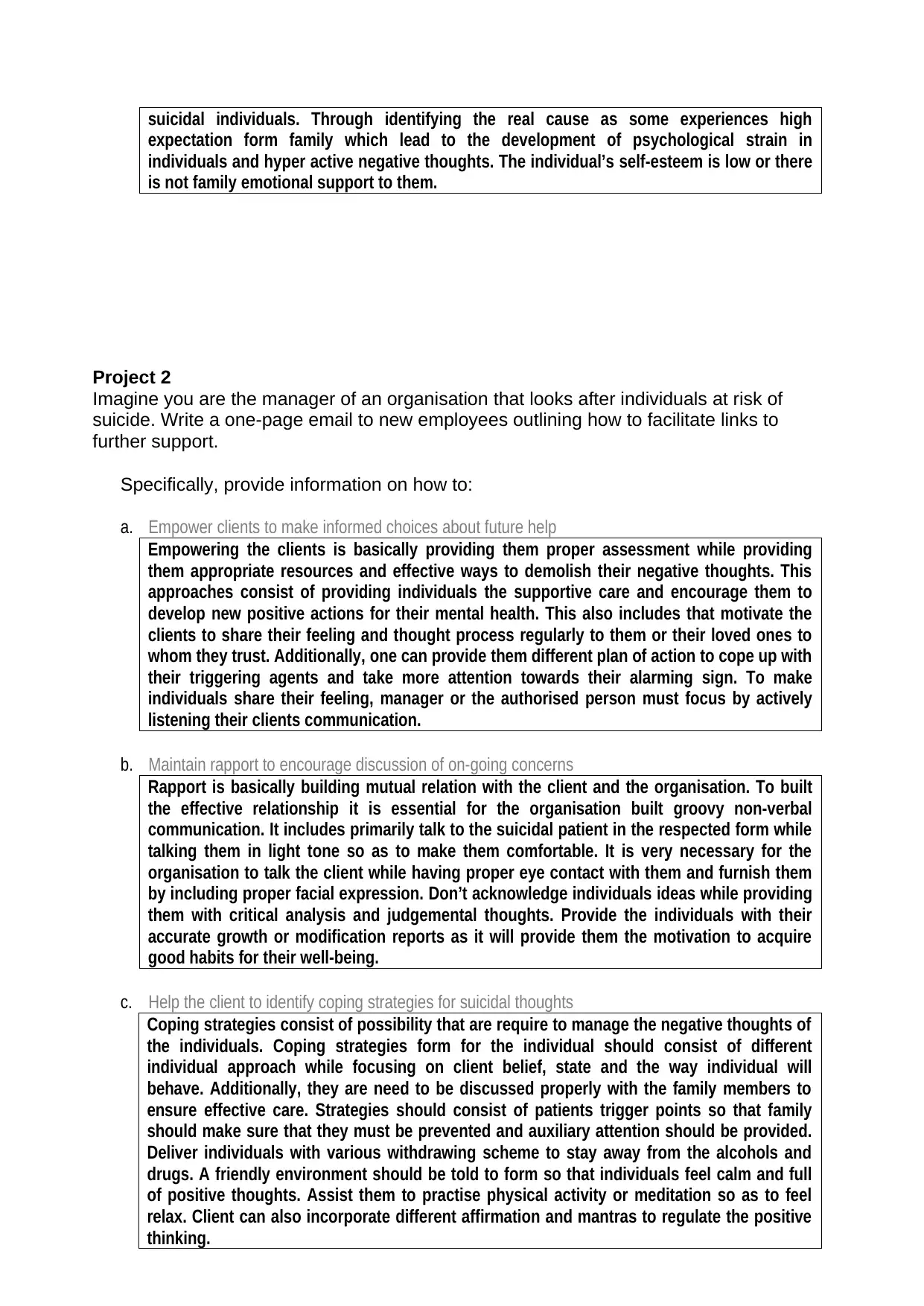
suicidal individuals. Through identifying the real cause as some experiences high
expectation form family which lead to the development of psychological strain in
individuals and hyper active negative thoughts. The individual’s self-esteem is low or there
is not family emotional support to them.
Project 2
Imagine you are the manager of an organisation that looks after individuals at risk of
suicide. Write a one-page email to new employees outlining how to facilitate links to
further support.
Specifically, provide information on how to:
a. Empower clients to make informed choices about future help
Empowering the clients is basically providing them proper assessment while providing
them appropriate resources and effective ways to demolish their negative thoughts. This
approaches consist of providing individuals the supportive care and encourage them to
develop new positive actions for their mental health. This also includes that motivate the
clients to share their feeling and thought process regularly to them or their loved ones to
whom they trust. Additionally, one can provide them different plan of action to cope up with
their triggering agents and take more attention towards their alarming sign. To make
individuals share their feeling, manager or the authorised person must focus by actively
listening their clients communication.
b. Maintain rapport to encourage discussion of on-going concerns
Rapport is basically building mutual relation with the client and the organisation. To built
the effective relationship it is essential for the organisation built groovy non-verbal
communication. It includes primarily talk to the suicidal patient in the respected form while
talking them in light tone so as to make them comfortable. It is very necessary for the
organisation to talk the client while having proper eye contact with them and furnish them
by including proper facial expression. Don’t acknowledge individuals ideas while providing
them with critical analysis and judgemental thoughts. Provide the individuals with their
accurate growth or modification reports as it will provide them the motivation to acquire
good habits for their well-being.
c. Help the client to identify coping strategies for suicidal thoughts
Coping strategies consist of possibility that are require to manage the negative thoughts of
the individuals. Coping strategies form for the individual should consist of different
individual approach while focusing on client belief, state and the way individual will
behave. Additionally, they are need to be discussed properly with the family members to
ensure effective care. Strategies should consist of patients trigger points so that family
should make sure that they must be prevented and auxiliary attention should be provided.
Deliver individuals with various withdrawing scheme to stay away from the alcohols and
drugs. A friendly environment should be told to form so that individuals feel calm and full
of positive thoughts. Assist them to practise physical activity or meditation so as to feel
relax. Client can also incorporate different affirmation and mantras to regulate the positive
thinking.
expectation form family which lead to the development of psychological strain in
individuals and hyper active negative thoughts. The individual’s self-esteem is low or there
is not family emotional support to them.
Project 2
Imagine you are the manager of an organisation that looks after individuals at risk of
suicide. Write a one-page email to new employees outlining how to facilitate links to
further support.
Specifically, provide information on how to:
a. Empower clients to make informed choices about future help
Empowering the clients is basically providing them proper assessment while providing
them appropriate resources and effective ways to demolish their negative thoughts. This
approaches consist of providing individuals the supportive care and encourage them to
develop new positive actions for their mental health. This also includes that motivate the
clients to share their feeling and thought process regularly to them or their loved ones to
whom they trust. Additionally, one can provide them different plan of action to cope up with
their triggering agents and take more attention towards their alarming sign. To make
individuals share their feeling, manager or the authorised person must focus by actively
listening their clients communication.
b. Maintain rapport to encourage discussion of on-going concerns
Rapport is basically building mutual relation with the client and the organisation. To built
the effective relationship it is essential for the organisation built groovy non-verbal
communication. It includes primarily talk to the suicidal patient in the respected form while
talking them in light tone so as to make them comfortable. It is very necessary for the
organisation to talk the client while having proper eye contact with them and furnish them
by including proper facial expression. Don’t acknowledge individuals ideas while providing
them with critical analysis and judgemental thoughts. Provide the individuals with their
accurate growth or modification reports as it will provide them the motivation to acquire
good habits for their well-being.
c. Help the client to identify coping strategies for suicidal thoughts
Coping strategies consist of possibility that are require to manage the negative thoughts of
the individuals. Coping strategies form for the individual should consist of different
individual approach while focusing on client belief, state and the way individual will
behave. Additionally, they are need to be discussed properly with the family members to
ensure effective care. Strategies should consist of patients trigger points so that family
should make sure that they must be prevented and auxiliary attention should be provided.
Deliver individuals with various withdrawing scheme to stay away from the alcohols and
drugs. A friendly environment should be told to form so that individuals feel calm and full
of positive thoughts. Assist them to practise physical activity or meditation so as to feel
relax. Client can also incorporate different affirmation and mantras to regulate the positive
thinking.
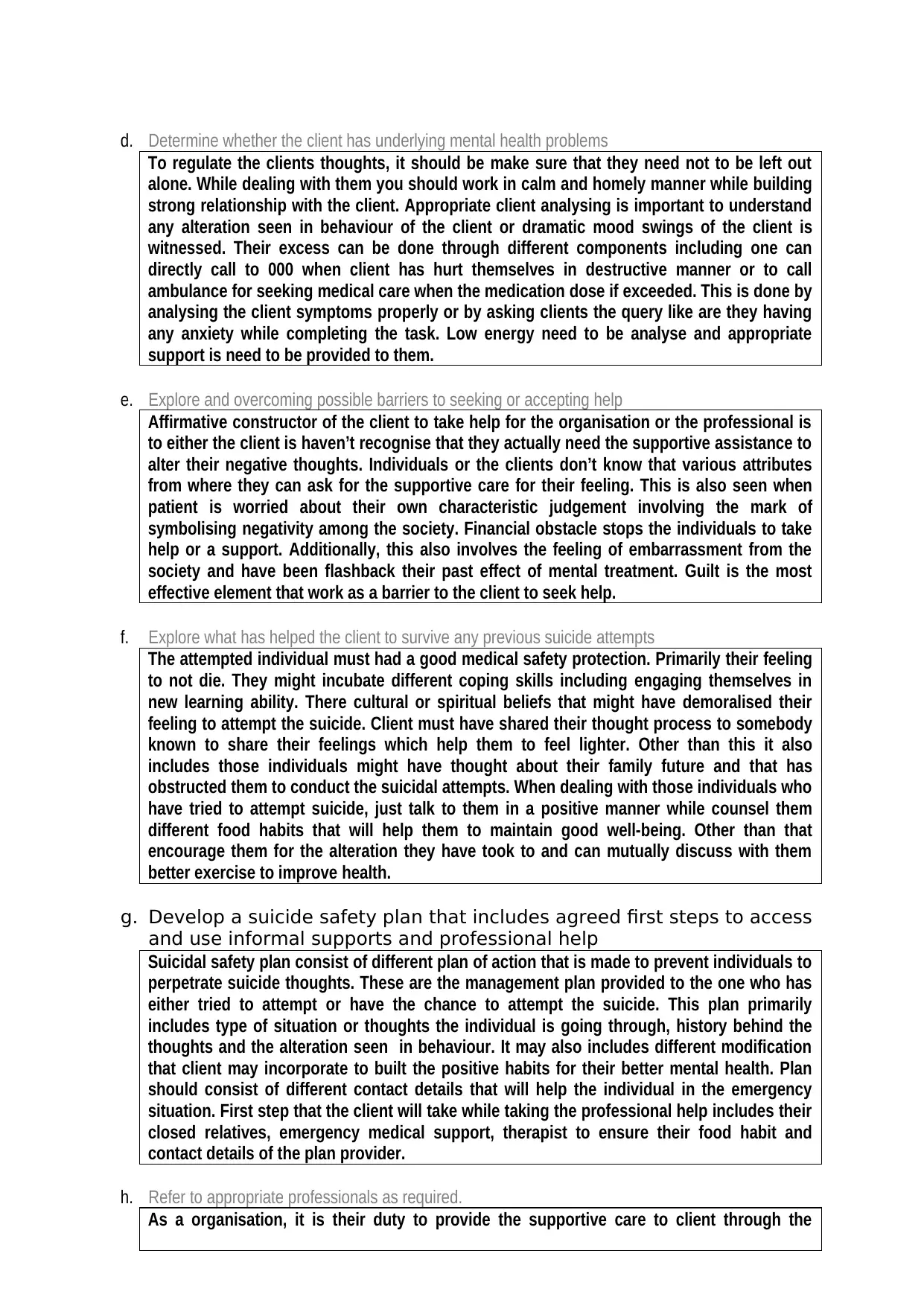
d. Determine whether the client has underlying mental health problems
To regulate the clients thoughts, it should be make sure that they need not to be left out
alone. While dealing with them you should work in calm and homely manner while building
strong relationship with the client. Appropriate client analysing is important to understand
any alteration seen in behaviour of the client or dramatic mood swings of the client is
witnessed. Their excess can be done through different components including one can
directly call to 000 when client has hurt themselves in destructive manner or to call
ambulance for seeking medical care when the medication dose if exceeded. This is done by
analysing the client symptoms properly or by asking clients the query like are they having
any anxiety while completing the task. Low energy need to be analyse and appropriate
support is need to be provided to them.
e. Explore and overcoming possible barriers to seeking or accepting help
Affirmative constructor of the client to take help for the organisation or the professional is
to either the client is haven’t recognise that they actually need the supportive assistance to
alter their negative thoughts. Individuals or the clients don’t know that various attributes
from where they can ask for the supportive care for their feeling. This is also seen when
patient is worried about their own characteristic judgement involving the mark of
symbolising negativity among the society. Financial obstacle stops the individuals to take
help or a support. Additionally, this also involves the feeling of embarrassment from the
society and have been flashback their past effect of mental treatment. Guilt is the most
effective element that work as a barrier to the client to seek help.
f. Explore what has helped the client to survive any previous suicide attempts
The attempted individual must had a good medical safety protection. Primarily their feeling
to not die. They might incubate different coping skills including engaging themselves in
new learning ability. There cultural or spiritual beliefs that might have demoralised their
feeling to attempt the suicide. Client must have shared their thought process to somebody
known to share their feelings which help them to feel lighter. Other than this it also
includes those individuals might have thought about their family future and that has
obstructed them to conduct the suicidal attempts. When dealing with those individuals who
have tried to attempt suicide, just talk to them in a positive manner while counsel them
different food habits that will help them to maintain good well-being. Other than that
encourage them for the alteration they have took to and can mutually discuss with them
better exercise to improve health.
g. Develop a suicide safety plan that includes agreed first steps to access
and use informal supports and professional help
Suicidal safety plan consist of different plan of action that is made to prevent individuals to
perpetrate suicide thoughts. These are the management plan provided to the one who has
either tried to attempt or have the chance to attempt the suicide. This plan primarily
includes type of situation or thoughts the individual is going through, history behind the
thoughts and the alteration seen in behaviour. It may also includes different modification
that client may incorporate to built the positive habits for their better mental health. Plan
should consist of different contact details that will help the individual in the emergency
situation. First step that the client will take while taking the professional help includes their
closed relatives, emergency medical support, therapist to ensure their food habit and
contact details of the plan provider.
h. Refer to appropriate professionals as required.
As a organisation, it is their duty to provide the supportive care to client through the
To regulate the clients thoughts, it should be make sure that they need not to be left out
alone. While dealing with them you should work in calm and homely manner while building
strong relationship with the client. Appropriate client analysing is important to understand
any alteration seen in behaviour of the client or dramatic mood swings of the client is
witnessed. Their excess can be done through different components including one can
directly call to 000 when client has hurt themselves in destructive manner or to call
ambulance for seeking medical care when the medication dose if exceeded. This is done by
analysing the client symptoms properly or by asking clients the query like are they having
any anxiety while completing the task. Low energy need to be analyse and appropriate
support is need to be provided to them.
e. Explore and overcoming possible barriers to seeking or accepting help
Affirmative constructor of the client to take help for the organisation or the professional is
to either the client is haven’t recognise that they actually need the supportive assistance to
alter their negative thoughts. Individuals or the clients don’t know that various attributes
from where they can ask for the supportive care for their feeling. This is also seen when
patient is worried about their own characteristic judgement involving the mark of
symbolising negativity among the society. Financial obstacle stops the individuals to take
help or a support. Additionally, this also involves the feeling of embarrassment from the
society and have been flashback their past effect of mental treatment. Guilt is the most
effective element that work as a barrier to the client to seek help.
f. Explore what has helped the client to survive any previous suicide attempts
The attempted individual must had a good medical safety protection. Primarily their feeling
to not die. They might incubate different coping skills including engaging themselves in
new learning ability. There cultural or spiritual beliefs that might have demoralised their
feeling to attempt the suicide. Client must have shared their thought process to somebody
known to share their feelings which help them to feel lighter. Other than this it also
includes those individuals might have thought about their family future and that has
obstructed them to conduct the suicidal attempts. When dealing with those individuals who
have tried to attempt suicide, just talk to them in a positive manner while counsel them
different food habits that will help them to maintain good well-being. Other than that
encourage them for the alteration they have took to and can mutually discuss with them
better exercise to improve health.
g. Develop a suicide safety plan that includes agreed first steps to access
and use informal supports and professional help
Suicidal safety plan consist of different plan of action that is made to prevent individuals to
perpetrate suicide thoughts. These are the management plan provided to the one who has
either tried to attempt or have the chance to attempt the suicide. This plan primarily
includes type of situation or thoughts the individual is going through, history behind the
thoughts and the alteration seen in behaviour. It may also includes different modification
that client may incorporate to built the positive habits for their better mental health. Plan
should consist of different contact details that will help the individual in the emergency
situation. First step that the client will take while taking the professional help includes their
closed relatives, emergency medical support, therapist to ensure their food habit and
contact details of the plan provider.
h. Refer to appropriate professionals as required.
As a organisation, it is their duty to provide the supportive care to client through the

friends, family and the mangers of the providers. Instead of that, when the organisation
feels that patient is required to consult the suitable professional to treat their intellectual
thought process. They need to seek the advice from experienced professionals for their
health condition. Organisation should provide the client with the recommendation plan
which consist of details of nutritional therapist as nutrition has a major impact on body
thoughts, professional psychologist as they will help to counsel the individual in faithful
manner according to their condition. Additionally, this includes different numbers and
services for the seeking help.
feels that patient is required to consult the suitable professional to treat their intellectual
thought process. They need to seek the advice from experienced professionals for their
health condition. Organisation should provide the client with the recommendation plan
which consist of details of nutritional therapist as nutrition has a major impact on body
thoughts, professional psychologist as they will help to counsel the individual in faithful
manner according to their condition. Additionally, this includes different numbers and
services for the seeking help.
1 out of 16
Related Documents
Your All-in-One AI-Powered Toolkit for Academic Success.
+13062052269
info@desklib.com
Available 24*7 on WhatsApp / Email
![[object Object]](/_next/static/media/star-bottom.7253800d.svg)
Unlock your academic potential
© 2024 | Zucol Services PVT LTD | All rights reserved.





